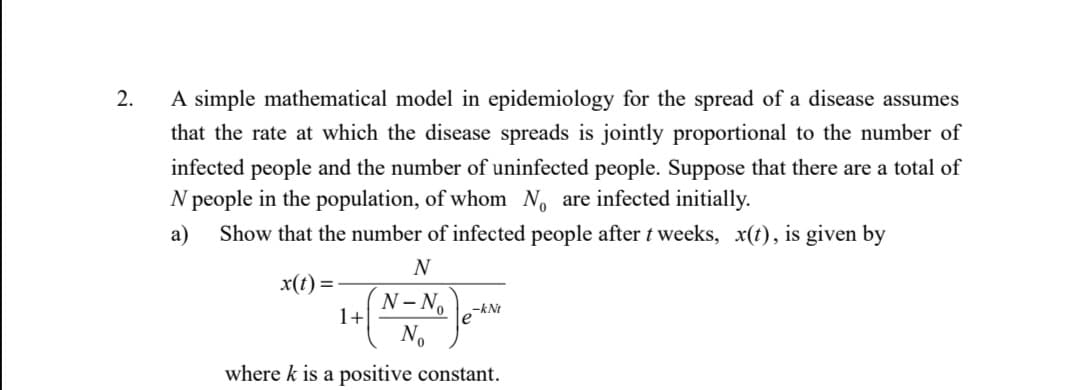2. A simple mathematical model in epidemiology for the spread of a disease assumes that the rate at which the disease spreads is jointly proportional to the number of infected people and the number of uninfected people. Suppose that there are a total of N people in the population, of whom No are infected initially. Show that the number of infected people after t weeks, x(t), is given by a) x(t) = N- No 1+ -kNt No where k is a nositive constant
2. A simple mathematical model in epidemiology for the spread of a disease assumes that the rate at which the disease spreads is jointly proportional to the number of infected people and the number of uninfected people. Suppose that there are a total of N people in the population, of whom No are infected initially. Show that the number of infected people after t weeks, x(t), is given by a) x(t) = N- No 1+ -kNt No where k is a nositive constant
Algebra & Trigonometry with Analytic Geometry
13th Edition
ISBN:9781133382119
Author:Swokowski
Publisher:Swokowski
Chapter5: Inverse, Exponential, And Logarithmic Functions
Section5.6: Exponential And Logarithmic Equations
Problem 64E
Related questions
Question

Transcribed Image Text:2.
A simple mathematical model in epidemiology for the spread of a disease assumes
that the rate at which the disease spreads is jointly proportional to the number of
infected people and the number of uninfected people. Suppose that there are a total of
N people in the population, of whom No are infected initially.
Show that the number of infected people after t weeks, x(t), is given by
a)
N
x(t) =
N- No
le
No
1+
-kNt
where k is a positive constant.
Expert Solution
This question has been solved!
Explore an expertly crafted, step-by-step solution for a thorough understanding of key concepts.
Step by step
Solved in 4 steps

Recommended textbooks for you

Algebra & Trigonometry with Analytic Geometry
Algebra
ISBN:
9781133382119
Author:
Swokowski
Publisher:
Cengage

Algebra & Trigonometry with Analytic Geometry
Algebra
ISBN:
9781133382119
Author:
Swokowski
Publisher:
Cengage